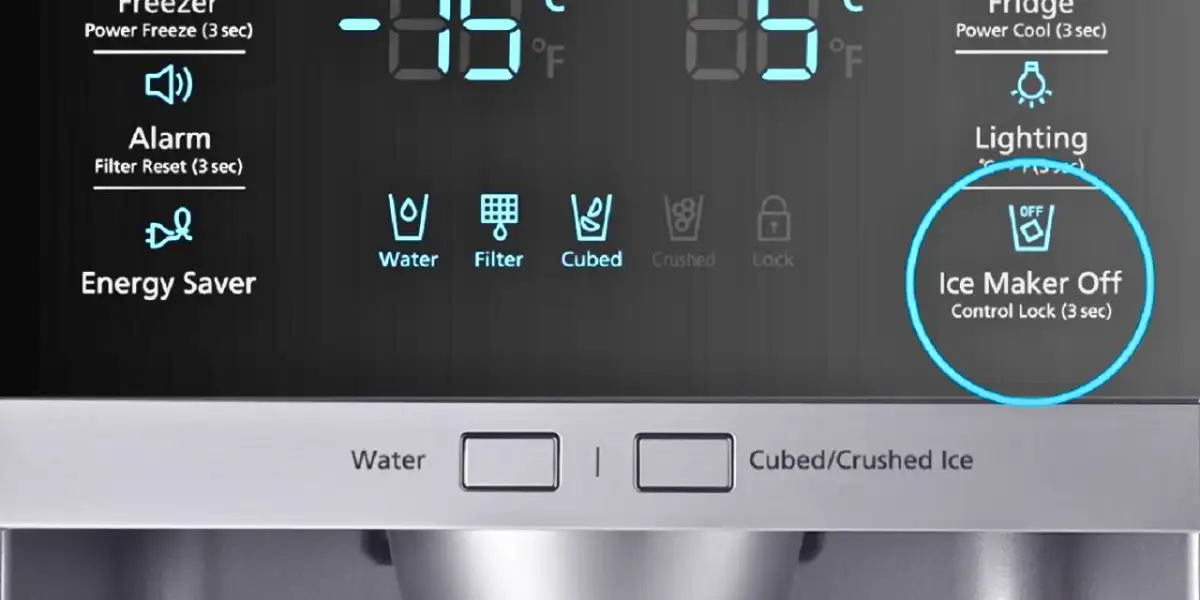
Turning off the ice maker in your GE side-by-side refrigerator can be a simple and effective way to prevent leaks, perform maintenance, or conserve energy. There are several methods for turning off the ice maker, depending on the model and manufacturer.
In this informative guide, we will explore some of the most common methods for turning off the ice maker in GE side-by-side models.
We will also discuss the benefits of turning off the ice maker and provide insights on how to maintain and care for your refrigerator after turning off the ice maker.
Steps to Turn Off the Ice Maker in GE Side-by-Side Models
Turning off the ice maker in your GE side-by-side refrigerator is a straightforward process. Here are the steps:
Locate the On/Off Switch
Look for a switch on the front of your ice maker. It may be labeled as “On/Off” or have symbols indicating the on and off positions.
Flip the Switch
If you see the on/off switch, simply flip it to the “Off” position. This will turn off the ice maker.
Check the Control Panel
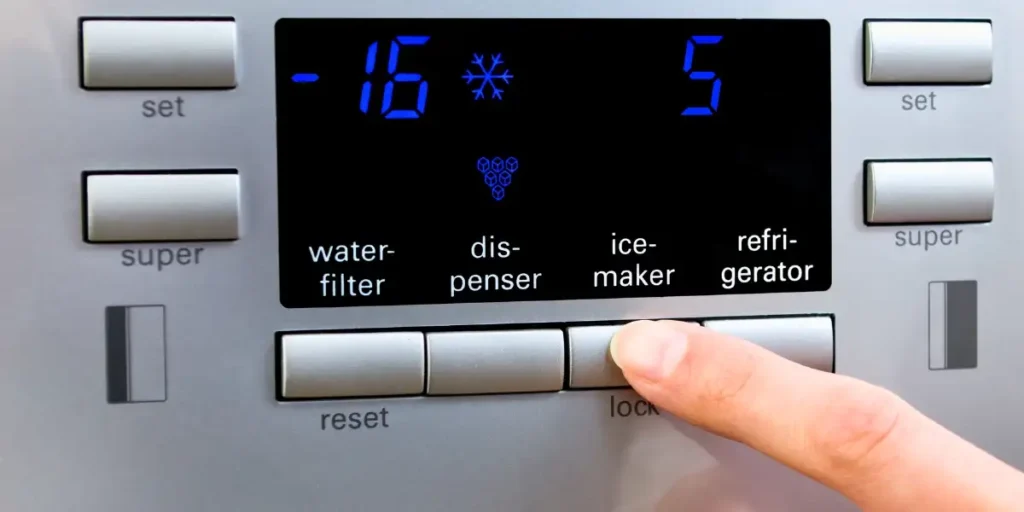
Some GE side-by-side models have an ice maker on/off selection on the control panel. Look for an “Icemaker” pad or setting on the display along with the temperature controls.
Consult your owner’s manual for specific instructions on turning the ice maker on or off using the control panel.
Slide Switch
Some ice makers have an on/off slide switch. The switch is labeled with “On” and “Off” positions. Slide the switch to the “Off” position to turn off the ice maker.
Reset the Ice Maker
If you are experiencing issues with the ice maker and want to reset it, you can turn off the power to the refrigerator for about five minutes.
This can help reset the ice maker and resolve any temporary issues. Refer to the refrigerator’s manual for specific instructions on resetting the ice maker.
Note: If your ice maker doesn’t have an obvious on/off switch or digital display option, consult your refrigerator’s user manual for specific instructions. If you’ve lost your manual, most manufacturers provide digital versions online.
Different Models and Their Specific Instructions
If you have older GE side-by-side models like the GSS20IEMBWW, GSS20IEMDWW, GSS20IEMEWW, and GSS20IEMFWW, follow this process:
Locate the Metal Wire Feeler Arm
Some older models also have a metal wire feeler arm on the side of the ice maker. To turn off the ice maker, simply raise this arm to the ‘stop’ (up) position.
Unplug the Refrigerator
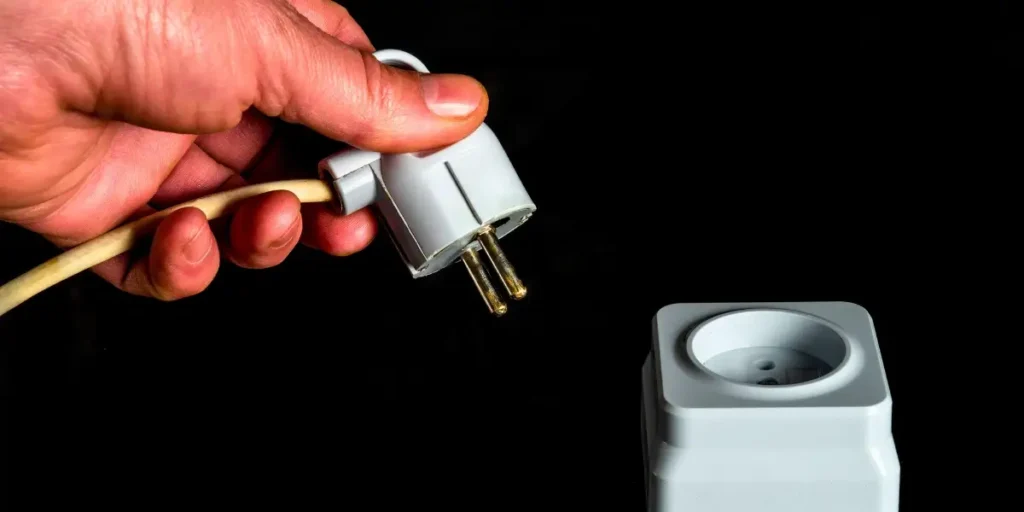
If you cannot find the on/off switch, you can unplug the refrigerator to turn off the ice maker. This is a simple and effective method for older models.
Troubleshooting Common Problems When Turning Off the Ice Maker of GE Side-by-side Refrigerator
Here are some common problems you might encounter when trying to turn off your GE side-by-side refrigerator’s ice maker, along with potential solutions:
Unresponsive Power Switch
If your power switch isn’t responding when you try to turn off your ice maker, it could be due to a faulty switch or an electrical issue.
Check the wiring and connections to ensure they are secure and replace the switch if necessary. In this case, you may also need to consult with a professional appliance repair service.
Unusual Noises
If you hear unusual noises coming from your refrigerator when trying to turn off your ice maker, it could indicate a mechanical problem. it may be due to a malfunctioning motor or fan. Check the motor and fan for damage or blockages and replace them if necessary.
Error Messages
If you see error messages on the control panel when turning off the ice maker, it may be due to a malfunctioning sensor or control board.
Consult the owner’s manual or contact GE support for guidance on troubleshooting and resolving the issue.
Water Leaks
If you notice water leaks when turning off the ice maker, it may be due to a clogged or damaged water line. Check the water line for clogs or damage and replace it if necessary.
Temperature Issues
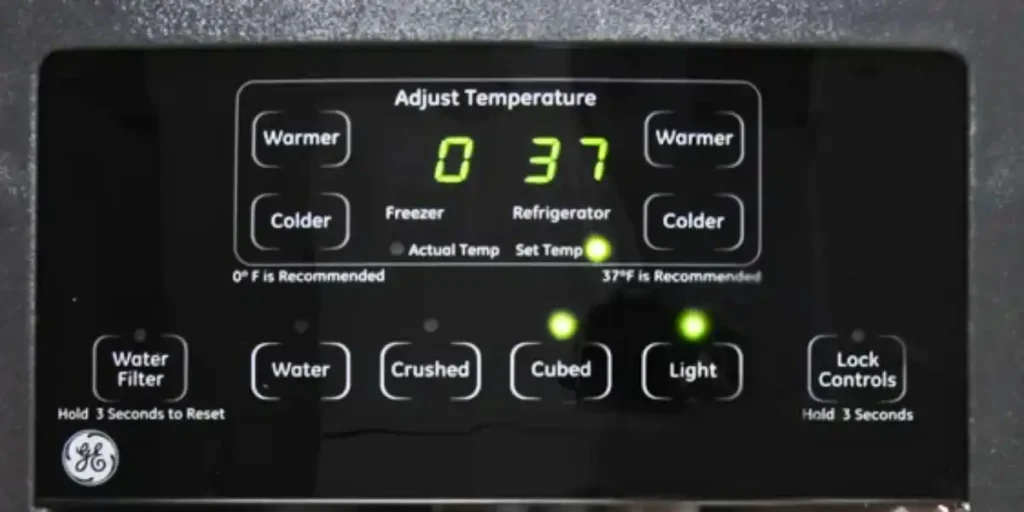
If the temperature in the refrigerator or freezer compartments is not optimal, it may affect the ice maker’s performance. Check the temperature settings and adjust them if necessary.
Unresponsive Ice Maker
If the ice maker is unresponsive or not producing ice, it may be due to a clogged water filter, low water pressure, or a malfunctioning motor or fan. Check the water filter and water pressure and replace the motor or fan if necessary.
Ice Maker Not Making Ice
If the ice maker is turned on but it’s not making ice, this could be due to a clogged water line or a faulty water inlet valve.
Check the water line for any blockages and ensure the water supply is turned on. If the problem persists, you may need to replace the water inlet valve.
Ice Cubes are small or hollow
If the ice cubes produced by the ice maker are smaller than usual or hollow, it could be due to low water pressure or a faulty water inlet valve.
Check your home’s water pressure and consider installing a booster if it’s too low. If the water pressure is fine, you may need to replace the water inlet valve.
Ice Tastes Bad
If the ice produced by the ice maker has a bad taste or odor, it could be due to stale or contaminated water, or a dirty ice bin.
Clean the ice bin and change the water filter if necessary. If the problem persists, have your water tested for contaminants.
Ice Maker Leaking Water
If there’s water leaking from the ice maker, this could be due to a cracked water line or a faulty water inlet valve. Check the water line for any cracks and replace it if necessary. If the line is fine, you may need to replace the water inlet valve.
Ice Maker Freezing Up
Is the ice maker freezing up and causing it to stop making ice? This could be due to a faulty thermostat or a leaky water inlet valve.
Check the thermostat for any faults and replace it if necessary. If the thermostat is fine, you may need to replace the water inlet valve.
Ice Dispenser Not Working
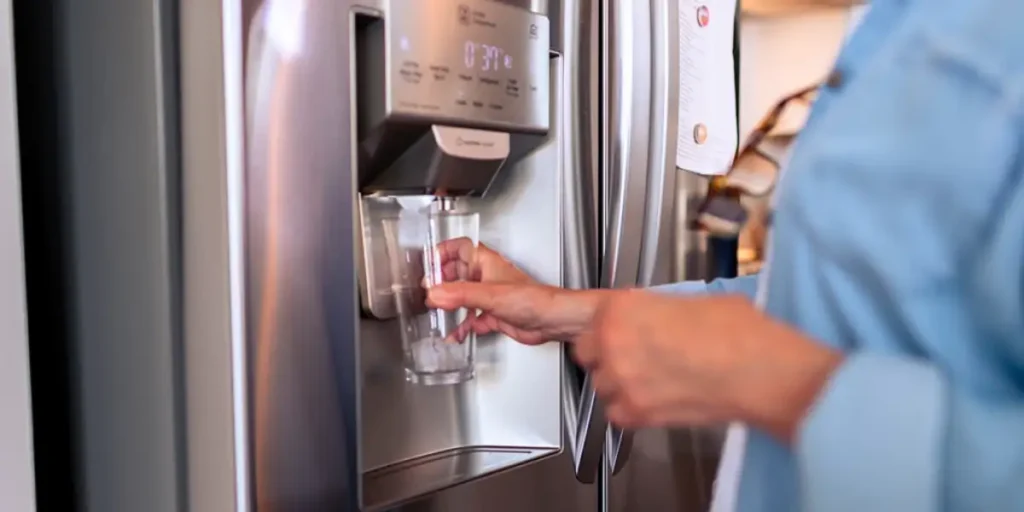
If the ice dispenser is not dispensing ice even though the ice maker is making ice, this could be due to a clogged dispenser chute or a faulty dispenser motor.
Check the chute for any blockages and clean it if necessary. If the chute is clear, you may need to replace the dispenser motor.
Maintenance and Care After Turning Off the Ice Maker of the GE side-by-side refrigerator
After turning off the ice maker of your GE side-by-side refrigerator, it is important to perform regular maintenance and care to ensure optimal performance. Here are some tips for maintaining and caring for your refrigerator:
Cleaning the Ice Maker
Regularly cleaning the ice maker can prevent clogs and ensure proper ice production. Use warm water and mild soap to clean the ice maker and surrounding areas. Avoid using harsh chemicals or abrasive materials that can damage the ice maker.
Storing the Ice Maker
If you need to store the ice maker for an extended period, make sure it is clean and dry. Store it in a cool, dry place to prevent damage or corrosion.
Regular Check-Ups
Perform regular check-ups on your refrigerator to ensure optimal performance. Check the temperature settings, condenser coils, and water lines for any issues or damage.
Consult the owner’s manual or contact GE support for guidance on troubleshooting and resolving any issues.
When to Turn It Back On
When you are ready to turn the ice maker back on, make sure the water supply is turned on and the ice maker is clean and dry. Refer to the specific model’s user manual for instructions on turning the ice maker back on.
Emptying the Ice Bin
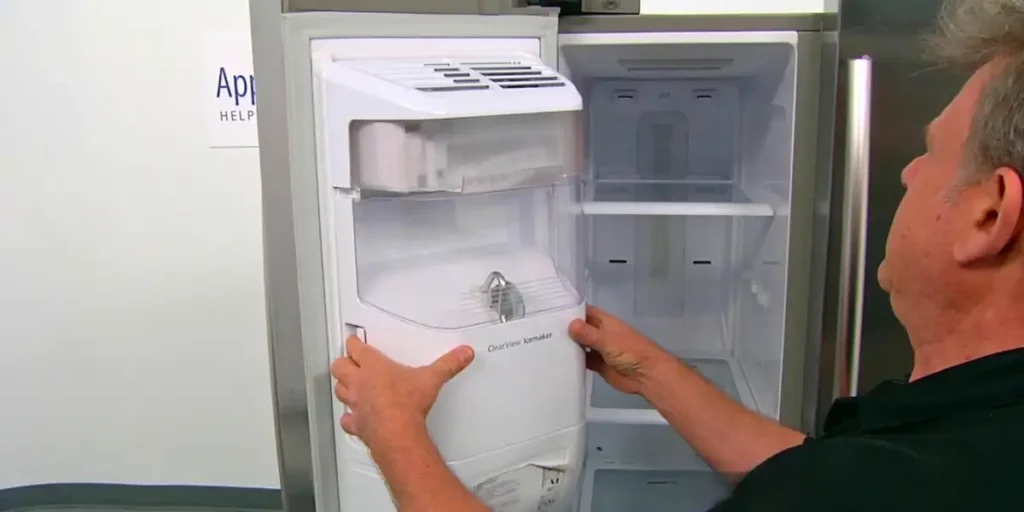
After turning off the ice maker, open the freezer. Find the ice bin. Take out the ice bin. Use both hands. Empty the ice into a container. Save or discard it. Wipe the bin dry. Use a clean towel.
Cleaning the Ice Maker
Turn off the ice maker. Find the switch or arm. Use a soft cloth. Dip it in warm, soapy water. Wipe the ice maker parts. Be gentle. Rinse with clean water. Dry everything well.
Inspecting the Water Line
Find the water line. It’s usually behind the fridge. Look for kinks or damage. Straighten if needed. Check for leaks. Feel with your fingers. Ask an adult if you find problems. They can help fix it.
Replacing the Filter
Locate the filter. It’s often inside the fridge. Follow the instructions. Each model is different. Remove the old filter. Put in a new one. Run water through it. Follow the manual’s directions.
Common Reasons for Turning Off GE Side-by-side Refrigerators
The ice maker in your GE side-by-side refrigerator is a complex piece of machinery. It uses a series of valves and switches to control the flow of water into an ice mold.
Once the water is frozen into cubes, a heater and a rotating arm push the cubes out into a collection bin.
There are several reasons why you might want to turn off your ice maker:
To Save Energy
The ice maker uses electricity to freeze water and eject ice cubes. Turning it off when not in use can help reduce your refrigerator’s energy consumption.
To Prevent Overflow
If the ice bin is full and the ice maker continues to produce ice, it can lead to overflow and potential damage.
For Maintenance or Repair
If your ice maker isn’t working properly, turning it off can prevent further damage while you troubleshoot the issue.
Vacation or Extended Absence
When going on vacation or leaving the house for an extended period, it is recommended to turn off the ice maker and water supply to the refrigerator to prevent any potential leaks or issues.
This is especially important if the refrigerator and freezer compartments are less than half full.
Temperature Control
If the room temperature is expected to drop below 60 degrees Fahrenheit, it is suggested to turn off the temperature control or unplug the unit.
This is because the refrigerator may cool less efficiently in colder temperatures. Refer to the owner’s manual for specific recommendations based on your model.
Maintenance or Cleaning
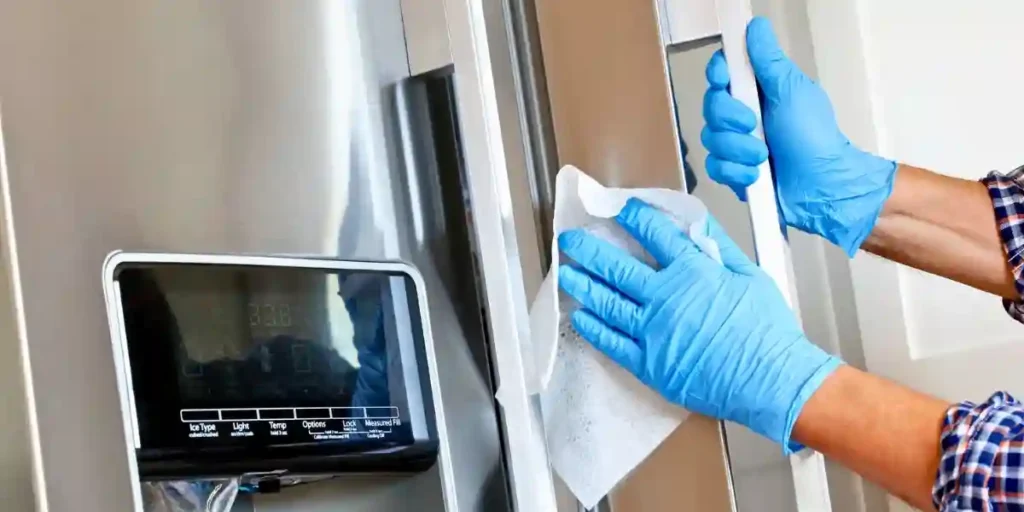
When performing maintenance or cleaning tasks on the refrigerator, it is advisable to turn off the ice maker and water supply. This ensures safety and prevents any accidental water leaks during the process.
Storage or Moving
If you are storing or moving the refrigerator, it is recommended to remove all food, turn off the circuit breaker or fuse that supplies power, and unplug the cord from the wall receptacle. Additionally, turn off the ice maker and water supply to prevent any potential leaks or damage.
Water Filter Replacement
When replacing the water filter in your GE side-by-side refrigerator, it is necessary to turn off the water supply to the refrigerator. This ensures a clean and hassle-free filter replacement process.
Icemaker Maintenance
If you need to perform maintenance or repairs on the icemaker, it is important to turn off the icemaker to ensure safety and prevent any potential water leaks or malfunctions. Refer to the specific model’s instructions for turning off the ice maker.
Unresponsive Power Switch
In some cases, the power switch of the icemaker may become unresponsive. In such situations, it is recommended to turn off the icemaker using the control panel or consult the owner’s manual for alternative methods.
Water Line Issues
If you suspect a water line issue or need to check the water line for leaks or damage, it is advisable to turn off the water supply to the refrigerator. This allows for safe inspection and troubleshooting.
Filter Replacement or Bypass
When replacing the water filter or using a bypass plug, it is necessary to turn off the water supply to the refrigerator. This ensures a smooth and hassle-free filter replacement process.
Noise Reduction
Ice makers can sometimes be noisy, especially when dropping ice into the bin. Turning it off can help reduce noise, especially during quiet hours.
FAQs
How often should I turn off my ice maker?
There’s no set rule for how often you should turn off your ice maker. It largely depends on your personal needs and usage habits.
Is it safe to leave the ice maker turned off for an extended period?
Yes, it’s safe to leave your ice maker turned off for an extended period. Just remember to remove any remaining water from the reservoir to prevent freezing damage.
What should I do if the ice maker won’t turn off?
If your ice maker won’t turn off, it could indicate a mechanical or electrical issue. Consult your user manual or contact GE’s customer service for assistance.
Can I turn off the ice maker without affecting other refrigerator functions?
Yes, turning off your ice maker should not affect other functions of your refrigerator.
Conclusion
Turning off the ice maker in your GE side-by-side refrigerator is a simple process that can help save energy and prevent potential damage. Whether you have an older model with a feeler arm or a newer model with digital controls, this guide has you covered.
Remember to regularly clean and maintain your ice maker to ensure its longevity and performance.
